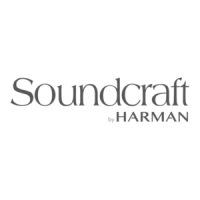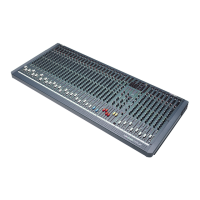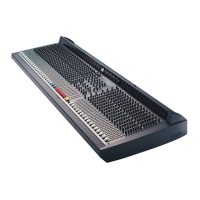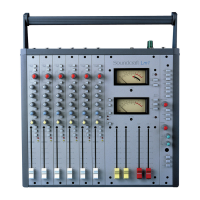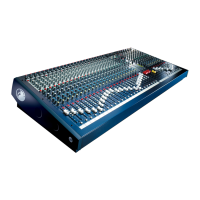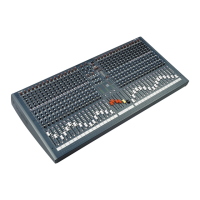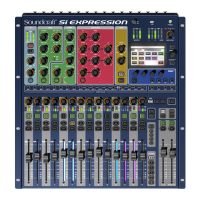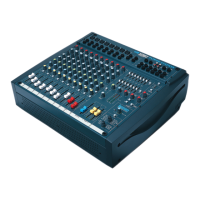Do you have a question about the SoundCraft LIVE 8 and is the answer not in the manual?
Alerts user to potential electric shock hazards.
Highlights important operating and maintenance instructions.
Provides useful information and tips on equipment operation.
Safety advice for headphone use and monitoring levels.
Advice on environmental conditions, cleaning, and interference avoidance.
Guidelines for safely moving and protecting the console.
Instructions for using the correct power supply cable.
Importance of correct input levels for performance.
Information on connecting the dedicated power supply unit.
Ensuring proper wiring for signal integrity and avoiding hum.
Earthing systems, clean/dirty power, isolation transformers.
Connecting audio equipment and troubleshooting interconnections.
Screen connection methods to prevent signal interference.
Details on selectable options using push-on jumpers.
Default and optional settings for auxiliary send source.
Default and optional settings for direct output source.
Default and optional settings for direct output pre-source.
Pin configuration for XLR inputs and outputs.
Pinout for balanced 1/4" jacks (inputs/outputs).
Pinout for stereo headphone jacks.
Pinout for 1/4" insert point jacks.
Diagrams illustrating XLR cable connections.
Diagrams for balanced 1/4" TRS jack leads.
Diagrams for unbalanced 1/4" TS jack leads.
Diagrams illustrating RCA phono cable connections.
Diagrams for insert cable connections.
Diagrams showing balanced 'Y' cable configurations.
Diagram for a headphone splitter cable.
Diagram for a headphone separator cable.
Diagrams showing unbalanced 'Y' cable configurations.
Detailed explanation of mono input channel features and controls.
Explanation of phantom power for microphones.
Function of the phase reversal switch.
How to set input gain for optimal signal levels.
Operation of the 100Hz high-pass filter.
Description of the 4-band EQ controls and features.
Function of the EQ bypass switch.
How auxiliary sends route signals for foldback and effects.
Explanation of the pan control for stereo imaging.
How to route signals to stereo mix or group busses.
Description of the channel fader for level control.
How to mute channels individually or via mute buses.
Function of PFL (Pre-Fade Listen) and Peak LEDs.
Details on the gain settings for cassette/CD inputs.
Routing mono sums to auxiliary buses for foldback/effects.
Using PFL to monitor stereo input signals.
Setting the stereo signal level to the main mix.
Overview of stereo input section features.
Matching input level for various stereo sources.
Description of HF and LF shelving EQ controls.
Function of the EQ bypass switch.
Routing signals to auxiliary buses for foldback/effects.
Control for balancing stereo signal to L/R outputs.
Routing stereo signals to Mix or Group busses.
Description of the channel fader for level control.
How to mute stereo channels or via mute buses.
Using PFL to monitor stereo input signals.
Description of the group faders for level control.
Routing group signals to the stereo mix or as mono subgroups.
Controlling group signal levels sent to matrix outputs.
Using PFL to monitor group signals.
Connecting and mixing external stereo sources.
Setting the final level for Mix outputs.
Controlling levels for matrix outputs.
Setting the final output level for matrix sections.
Connecting and routing the talkback microphone.
Monitoring the console's power supply status.
Master level controls and AFL switches for auxiliary sends.
Indicator LED for active PFL/AFL signals.
Control for the headphone output level.
Summing L&R outputs to check for phasing.
Controlling mute groups via master switches.
Description of the headphone output jack.
A typical configuration for sound reinforcement systems.
Configuration for live sound with a voice cluster and mono fill.
Expanding stereo inputs using stereo returns.
Application for driving multiple loudspeaker outputs for spot effects.
Alerts user to potential electric shock hazards.
Highlights important operating and maintenance instructions.
Provides useful information and tips on equipment operation.
Safety advice for headphone use and monitoring levels.
Advice on environmental conditions, cleaning, and interference avoidance.
Guidelines for safely moving and protecting the console.
Instructions for using the correct power supply cable.
Importance of correct input levels for performance.
Information on connecting the dedicated power supply unit.
Ensuring proper wiring for signal integrity and avoiding hum.
Earthing systems, clean/dirty power, isolation transformers.
Connecting audio equipment and troubleshooting interconnections.
Screen connection methods to prevent signal interference.
Details on selectable options using push-on jumpers.
Default and optional settings for auxiliary send source.
Default and optional settings for direct output source.
Default and optional settings for direct output pre-source.
Pin configuration for XLR inputs and outputs.
Pinout for balanced 1/4" jacks (inputs/outputs).
Pinout for stereo headphone jacks.
Pinout for 1/4" insert point jacks.
Diagrams illustrating XLR cable connections.
Diagrams for balanced 1/4" TRS jack leads.
Diagrams for unbalanced 1/4" TS jack leads.
Diagrams illustrating RCA phono cable connections.
Diagrams for insert cable connections.
Diagrams showing balanced 'Y' cable configurations.
Diagram for a headphone splitter cable.
Diagram for a headphone separator cable.
Diagrams showing unbalanced 'Y' cable configurations.
Detailed explanation of mono input channel features and controls.
Explanation of phantom power for microphones.
Function of the phase reversal switch.
How to set input gain for optimal signal levels.
Operation of the 100Hz high-pass filter.
Description of the 4-band EQ controls and features.
Function of the EQ bypass switch.
How auxiliary sends route signals for foldback and effects.
Explanation of the pan control for stereo imaging.
How to route signals to stereo mix or group busses.
Description of the channel fader for level control.
How to mute channels individually or via mute buses.
Function of PFL (Pre-Fade Listen) and Peak LEDs.
Details on the gain settings for cassette/CD inputs.
Routing mono sums to auxiliary buses for foldback/effects.
Using PFL to monitor stereo input signals.
Setting the stereo signal level to the main mix.
Overview of stereo input section features.
Matching input level for various stereo sources.
Description of HF and LF shelving EQ controls.
Function of the EQ bypass switch.
Routing signals to auxiliary buses for foldback/effects.
Control for balancing stereo signal to L/R outputs.
Routing stereo signals to Mix or Group busses.
Description of the channel fader for level control.
How to mute stereo channels or via mute buses.
Using PFL to monitor stereo input signals.
Description of the group faders for level control.
Routing group signals to the stereo mix or as mono subgroups.
Controlling group signal levels sent to matrix outputs.
Using PFL to monitor group signals.
Connecting and mixing external stereo sources.
Setting the final level for Mix outputs.
Controlling levels for matrix outputs.
Setting the final output level for matrix sections.
Connecting and routing the talkback microphone.
Monitoring the console's power supply status.
Master level controls and AFL switches for auxiliary sends.
Indicator LED for active PFL/AFL signals.
Control for the headphone output level.
Summing L&R outputs to check for phasing.
Controlling mute groups via master switches.
Description of the headphone output jack.
A typical configuration for sound reinforcement systems.
Configuration for live sound with a voice cluster and mono fill.
Expanding stereo inputs using stereo returns.
Application for driving multiple loudspeaker outputs for spot effects.
| Channels | 8 |
|---|---|
| Mic Preamps | 8 |
| Line Inputs | 8 |
| Aux Sends | 2 |
| Faders | 8 |
| Built-in Effects | No |
| Phantom Power | Yes |
| USB Interface | No |
| EQ Bands | 3 |
| Headphone Output | 1 |
| Type | Analog Mixer |
| Other Inputs | Stereo |
